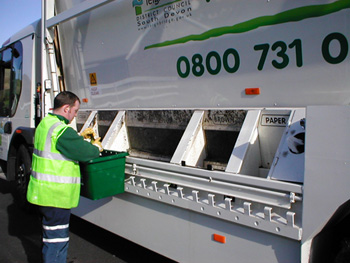May 23, 2005
Got Waste? The Debate Over Recycling
By Michael D. Shaw
Just how much of what we do every day is based on popular fads or fashion—as opposed to cold, scientific reason? More than most of us would want to admit, I’m afraid.
The global cooling scare of the 1970’s morphed into today’s global warming. Breast feeding, presumably a proven commodity over human and mammalian history for millions of years, fell out of favor in the 1950’s as not being “modern,” and even gross. How many baby boomers were raised on the notion that having meat for at least all three meals, seven days a week, was the only way to build strong American bodies? And, who wasn’t indoctrinated into the feel-good notion, raised to a religious precept by some, that recycling is the cornerstone of any waste management program, and must be practiced by all people all the time?
It was nine years ago that John Tierney’s landmark article, entitled “Recycling Is Garbage” appeared in the New York Times Magazine. Focusing primarily on recycling efforts in New York City, he exposed the high expenses in collecting and separating the garbage, and the lack of demand for most of the resulting materials. Moreover, in some cases, such as recycling newspaper, more water pollution ensues (owing to removing the ink), than in making new paper. Besides, trees are specifically grown for this purpose, and are a renewable resource.
He also reassured the public on landfill site availability, noting that if Americans keep generating garbage at current rates for the next 1,000 years, and if all this refuse is put in a landfill 100 yards deep, by the year 3000, this accumulation of trash will fill a plot of land 35 miles on each side. This area, by the way, is about 5 percent the size of the space needed for solar panels, as touted by various environmental groups.
So, what’s the big deal? Would it surprise you that the incident behind the hysteria over landfills, the infamous 1987 voyage of the barge Mobro 4000, containing 3,168 tons of Long Island trash, is a complete travesty? Chartered by entrepreneur Lowell Harrelson and Long Island mob boss Salvatore Avellino, the craft was headed for a pilot program in Morehead City, North Carolina to be turned into methane. But, before the barge reached its destination, a rumor began to circulate (never verified and most likely untrue) that the load contained medical waste. At that, the permits to unload were denied, and it continued to travel south, facing military force in Mexico, before finally arriving at a Brooklyn incinerator five months later.
Thus, given the bad publicity of mob ties and a vicious rumor, the recycling craze was born. Ironically, there never was a problem with finding a Long Island landfill. The whole thing occurred because Harrelson was trying to beat the high tipping fees of the local facilities, and assure himself of a big profit.
Tierney made many other strong points in his article, including a defense of Styrofoam coffee cups and the amount of waste at fast food restaurants. But, save a quick rebuttal from the Environmental Defense Fund (EDF), few voices were raised in opposition to his startlingly contrarian piece. As it was, the EDF essay contained numerous examples of classical fallacies in logic, and must have been embarrassing to even the group’s most ardent supporters.
Are there any good news recycling stories? Certainly. Aluminum recycling is one of the original triumphs. Glass waste has been used in the production of new glass for decades. Engineered wood products, melding sawmill waste with newly harvested forest products, offer advantages over conventional goods in price, strength, and durability.
There is also an active market in plastics recycling. Poly-Wood, Inc. transforms milk jugs, once destined for landfills, into recycled plastic lumber used to create a pleasing line of casual outdoor furniture. For my money, it beats wicker and wood hands down. Recycline manufactures a range of personal care items, all from recycled plastic. The company also supplies postpaid mailers, for return of the products, into their destiny as plastic lumber.
Plastic, far from being an environmental villain, as it has been portrayed, is proving itself to be highly recyclable, into products people actually want to buy. This should come as no surprise, since regrinding of plastic molding waste, for all applications except those that require clarity, is standard procedure. And, while paper is more biodegradable than plastic, this, too is a false issue, since in the low oxygen environment of landfills, neither paper nor plastic break down all that much. Another fad shattered?
Recycling surely has its place, and its role is growing, but it is not the holy grail. And, neither is technology the enemy, for without it, there would scant time for environmental reason, or environmental reverie, for that matter.

